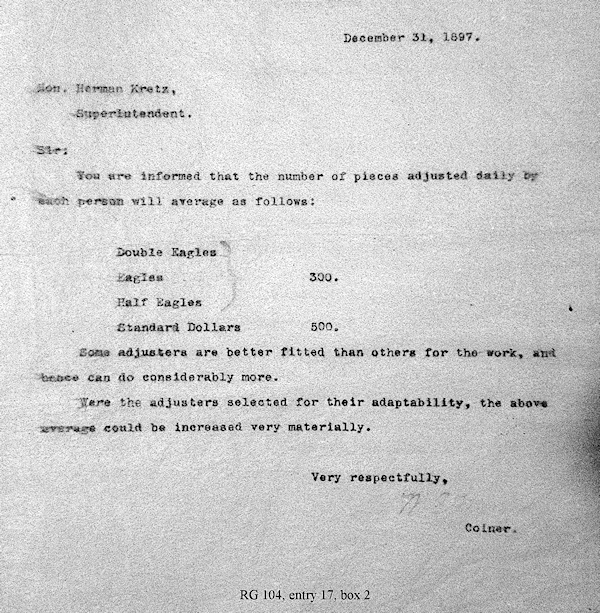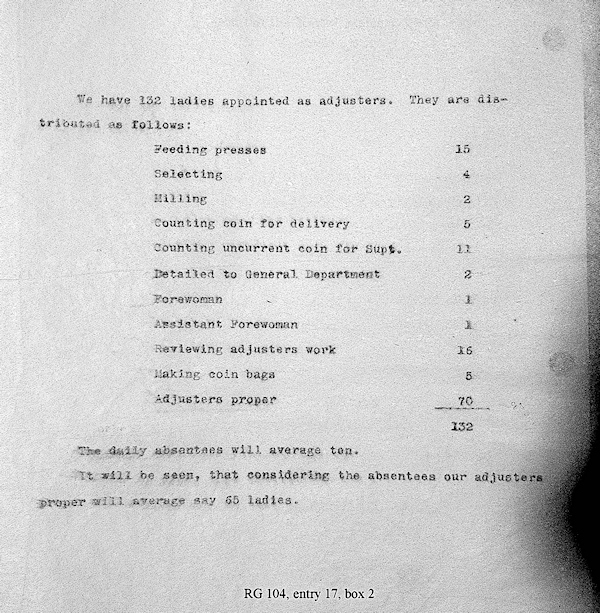Staffing required to run the Philadelphia Mint - 1890s
 RogerB
Posts: 8,852 ✭✭✭✭✭
RogerB
Posts: 8,852 ✭✭✭✭✭
This letter will give members perspective on the importance of women working at the Philadelphia Mint and the numbers assigned to various duties. Notice that 70 adjusters were required to manually check gold coin blanks and completed pieces. (The work week was 5-1/2 days, with Saturday afternoon and Sunday off.)


4
Comments
PS: This is the women's dining room at the US Treasury in 1910. The Philadelphia Mint dining room was smaller and partially separated from changing areas by hanging curtains. Notice the potted plants placed on small shelves above the ladies' heads...ready to conk someone on the hair bun! Although small and somewhat bare, the room does have two large plasma TV screens at one end. ( )
)
Interesting... I wonder how early they needed to get up to put their hair up in such elaborate coiffure's.....Or did they sleep with their head on a rack? The picture does not show it, but I assume there was a glass ceiling in that room.... Cheers, RickO
Cheers, RickO
As I understand it from some historians of women's styles, women of that era kept their hair long. The bun hairstyle was a quick and easy way to keep hair out of work space. It was taken down at night. There's a whole bunch of related stuff on the SI site for the National Women's History Museum; also see National Museum of Women in the Arts.
Interesting, as always.
There must have been quite a bit of uncurrent coin flowing back to the Mint to require 11 ladies to count it.
Those are not plasma TVs. Those were state of the art coal-fired microwave ovens!
Ahhhh....that's why the screens are blank !
Yup. There's several ledgers in NARA detailing the types and quantities of returned coin. I can send you the entry numbers, if you'd like. I went thru them years ago to get the melt figures for large cents. No half cents were listed, so I'm guessing that they counted 2 hc's as a cent.
Thank you for another informative historical post.
The first page posted regarding daily goals resonates with me.
Fresh out of school I landed a job as a manufacturing engineer in a factory.
One of my duties was to do time studies, design work stations and set the daily production goals for various processes.
It is true how a few people can be freaky fast and accurate at a certain repetitious task while others labor and rarely reach their goals.
I'm sure the Mint had a few super hero adjuster ladies and they got first pick at seating in that lunch room.
"If I say something in the woods and my wife isn't there to hear it.....am I still wrong?"
My Washington Quarter Registry set...in progress
Back in 2014 I wrote an article for COINage about how during the Great Depression some people were hard up for cash, and inevitably some old family heirloom coins got spent. I used the Mint Reports to get figures on how many obsolete coins had been turned in both before and after things got bad. Here is part of a paragraph from the article:
"In Calendar Years 1925 through 1929, which I am using as my base period, the Treasury redeemed 47,643 large cents, for an average of 9,529 per year. In CY 1935 alone, they redeemed 24,536. (In case you were wondering, in the same base period they redeemed 128 half cents, vs. 32 in CY35.)"
A bit later I noted that 206 Half Cents had been melted in Calendar Year 1937.
Great info! Thanks.
RE: "I'm sure the Mint had a few super hero adjuster ladies and they got first pick at seating in that lunch room."
Clarification - the photo is of the ladies' dining room in Treasury, 1910, not the Philadelphia Mint.
Other reports from the 1880s and 90s break down adjuster productivity by individual and denomination. Some women were so good that they often did not use their balance, even though all work was double checked ("reviewing adjuster's work" group). Others never got the hang of it - at least not to Mint standards - and were eventually replaced.